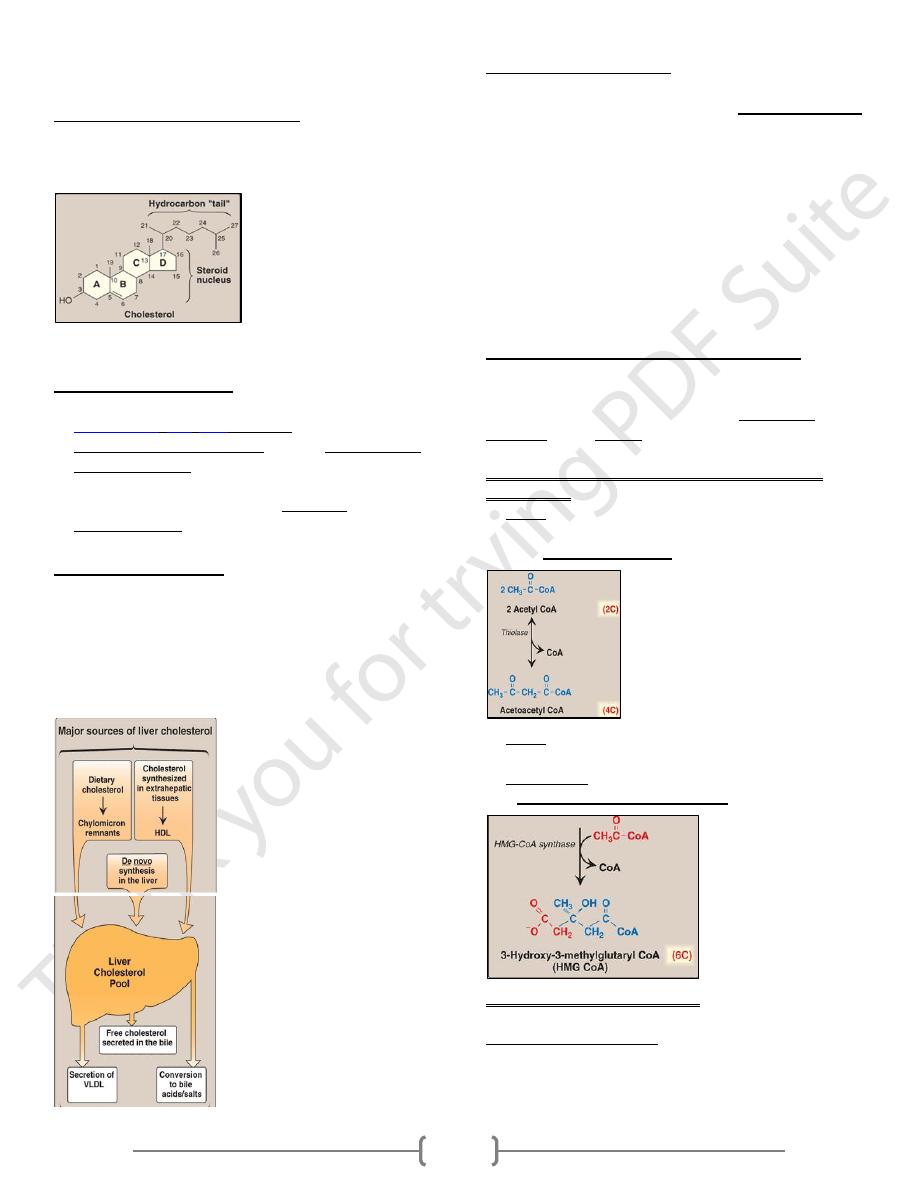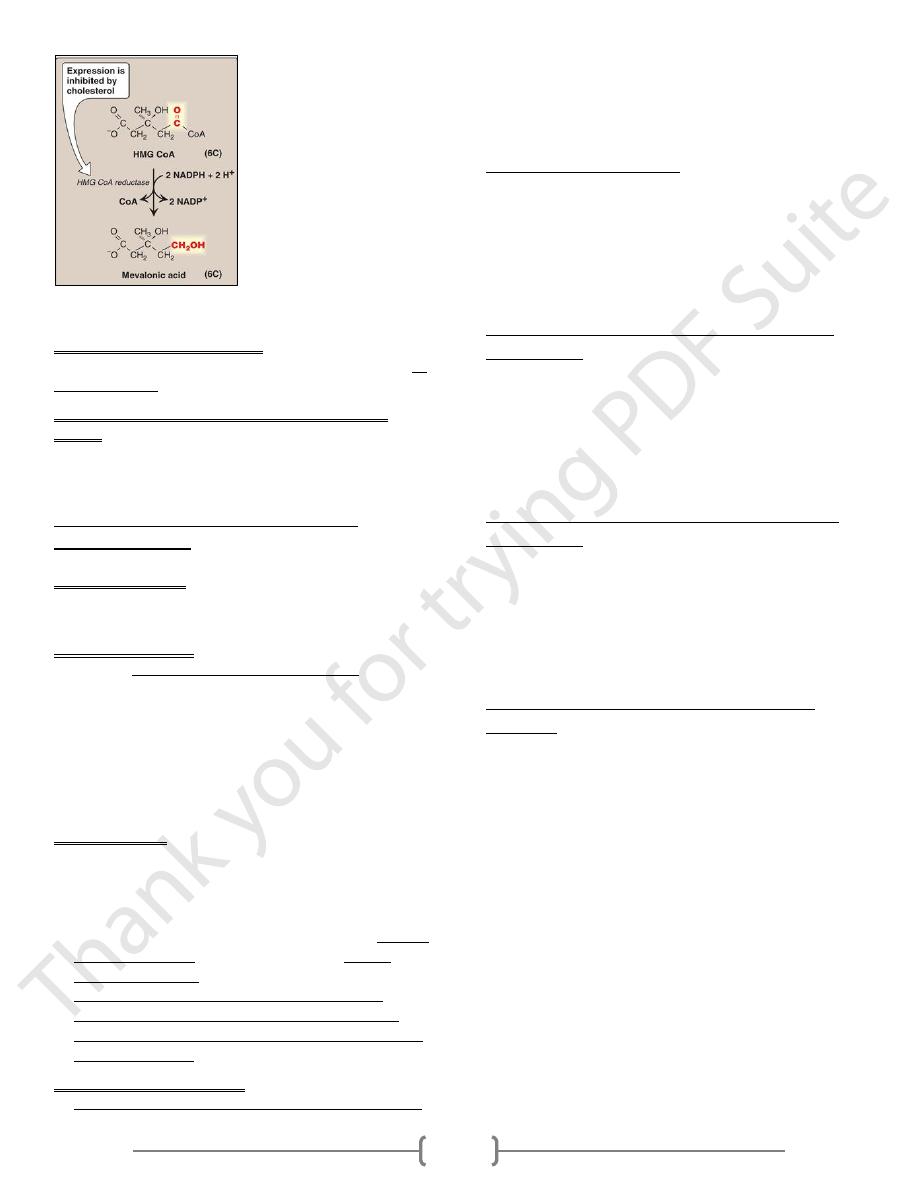
11
Lec.6 Cholesterol metabolism
Cholesterol present in the body:-
1- Sterols: steroid hormone ex. Estrogen.
2- Cholesterol:
A. Free cholesterol (unesterified)
B. Cholesteryl ester (esterified at C3 with FA), storage form.
Transport of cholesterol
• Cholesterol travels in the blood stream complexed in
Chylomicrons
,
IDL
,
LDL
, and HDL.
• LDL is richest in cholesterol & transport Free cholesterol
& Cholesteryl ester from liver to many tissues, while
• HDL transport both types from tissues to the liver, where it
is eliminated from the body either unchanged or after
conversion to bile acids.
Source of cholesterols:
1- Exogenous source:
(Chylomicrons)
2- Endogenous source:
a) De novo synthesis of by liver
(Transport to the tissues by LDL)
b) Extrahepatic synthesis
(Transfer from tissues by HDL)
Absorption of cholesterol
• Esterified cholesterol in the diet is hydrolyzed in the
intestine to free cholesterol & FFA by cholesterol esterase
(from pancreas &small intestine).
• all cholesterol in the intestine present as unesterified
form, which is solubilized through formation of mixed
micelles that contain unesterified cholesterol, FA,
monoglycerides, phospholipids& conjugated bile acid
• The quantity of cholesterol absorbed determined by the
amount that can be solubilized by micelles. After
absorption into intestinal mucosal cells, cholesterol, TG,
PL, & apoprotein (ApoB) incorporated into chylomicron
which enter lymphatics then to systemic venous circulation
Biosynthetic pathway of Cholesterol
Made from Acetyl-CoA in 4 stages:
All tissues containing nucleated cells are capable of
cholesterol synthesis, which occurs in the endoplasmic
reticulum and the cytosol .
1) Stage 1: Synthesis of hydroxy – methylglutaryl- CoA
(HMG-CoA).
A. Step 1: Two molecules of acetyl-CoA condense to form
acetoacetyl-CoA.
Enzyme: Thiolase (in cytosol)
B. Step 2: 3
rd
acetyl-CoA condenses with acetoacetyl-CoA to
yield the 6C compound hydroxy-methylglutaryl- CoA
(HMG-CoA).
Enz : HMG-CoA Synthase (in cytosol).
2) Stage 2: Synthesis of Mevalonate.
A. Step 1: reduction of HMG-CoA to mevalonate
Enz: HMG-CoA reductase .
(RLS) in the pathway of cholesterol synthesis and is the site of
action of the most effective class of cholesterol-lowering
drugs, the HMG-CoA reductase inhibitors (statins).

12
B. Step2: decarboxylation of mevalonate to 5C isoprenoid.
3) Stage 3: Formation of Squalene .
Condensation of 6 activated (5C isoprene units) to produce 30
C linear squalene.
4) Stage 4: Conversion of squalene to the 4 ring steroid
nucleus
Cyclization of squalene to form 4 rings steroid nucleus
Lanosterol.
Regulation of cholesterol synthesis
HMH-CoA reductase
Subject to different kinds of metabolic control:
1) Feedback inhibition:
Cholesterol & mevalonate feedback inhibitors of HMG-CoA
reductase, thus decreasing further cholesterol synthesis.
2) Hormonal regulation:
Modified by Phosphorylation - dephosphorylation:
Glucagon or glucocorticoids:
favors formation of the inactive phosphorylated HMG-CoA
reductase & decreases the rate of cholesterol synthesis.
Insulin or thyroid hormone:
Increases HMG-CoA reductase activity, by
dephosphorylation of the enzyme & results in an increase
in the rate of synthesis.
3) Gene expression :
Sterol-mediated regulation of transcription:
• The amount of mRNA produced is modulated by the
supply of cholesterol.
• When cholesterol is in excess in the diet, causes a decrease
in transcription of the HMG-CoA reductase gene (decrease
mRNA production), leading to a decrease in de novo
cholesterol synthesis.
• Attempts to lower plasma cholesterol in humans by
reducing the amount of cholesterol in the diet produce
variable results [only hepatic synthesis that is inhibited by
dietary cholesterol].
4) Inhibition by drugs (Statins ):
reversible competitive inhibitors of HMG-CoA reductase;
They are used to decrease cholesterol levels in patients
with hypercholesterolemia.
This should accompany by decrease of cholesterol intake
in order to be effective.
Degradation of cholesterol
• The ring structure of cholesterol cannot be metabolized to
CO2 & H2O in humans; rather intact sterol ring is eliminated
from the body.
• About 1 g of cholesterol is eliminated from the body/day.
1- Half is excreted in the feces after conversion to bile acids .
2- The remainder is excreted as cholesterol .
Factors increasing intracellular free cholesterol
concentration
• de novo biosynthesis
• hydrolysis of intracellular cholesterol esters by the enzyme
cholesterol ester hydrolase
• dietary intake of cholesterol and uptake from chylomicrons
• receptor-mediated uptake of cholesterol-containing
lipoproteins (LDL)
Factors decreasing intracellular free cholesterol
concentration
• inhibition of cholesterol biosynthesis
• Down regulation of the LDL receptor
• intracellular esterification of cholesterol by acyl-coenzyme
A:cholesterol acyl transferase
• release of cholesterol to HDL
• conversion of cholesterol to bile acids or steroid hormones
Factors influencing the activity of HMG-CoA
reductase
• intracellular concentration of HMG-CoA
• intracellular concentration of cholesterol
• hormones:
insulin, tri-iodothyronine (+);
glucagon, cortisol (-)

13
م
خطط
مف
يد لكل المحاضرات
